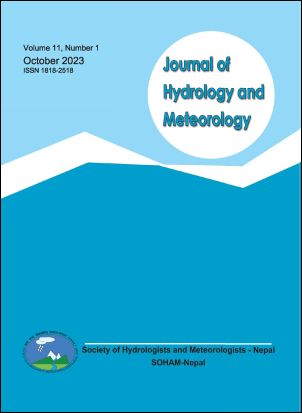Flow Transfer through Spatially Distributed Hydrological (SPHY) Model in Tamakoshi River Basin of Nepal
DOI:
https://doi.org/10.3126/jhm.v11i1.59662Keywords:
SPHY Model, Ungauged River, Trans-boundary, Himalayan River BasinsAbstract
The availability of continuous hydrological records, both spatially and temporally, is often limited. This research employed a fully distributed Spatial Process in HYdrology (SPHY) model within the Tamakoshi River Basin to address this gap. The SPHY model was calibrated from 2004 to 2008 with NSE 0.62 at Busti station of Tamakoshi [2933.29 km2] and validated from 2004 to 2008 with NSE 0.76 at Rasnalu station of Khimti [322.58 km2]. Conversely, SPHY model was calibrated from 2004 to 2008 with NSE 0.79 at Rasnalu station of Khimti and validated from 2004 to 2008 with NSE 0.61 at Busti station of Tamakoshi. The observed annual average discharge at Busti station was 1632 m3 /s and Rasnalu station was 261 m3 /s during the simulation period. The annual average discharges at Benighat [862.09 km2 downstream] transferred from Busti and Rasnalu models are 1963.1 m3 /s and 1961.32 m3 /s, respectively. Daily streamflow generated at Benighat from Busti and Rasnalu stations, closely aligns and perfectly matches and highly correlates, with the coefficient of determination 0.99. SPHY model is a good technique for prediction of flows in ungauged basins of Himalayan region. The SPHY model emerges as a robust technique for predicting discharge within the Himalayan River basin. This research holds the potential to serve as a valuable reference for generating streamflow data at ungauged locations, that are vital for planning, management and development of water resource projects.




